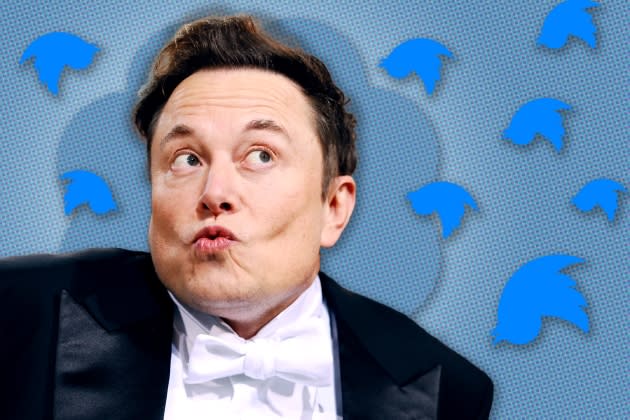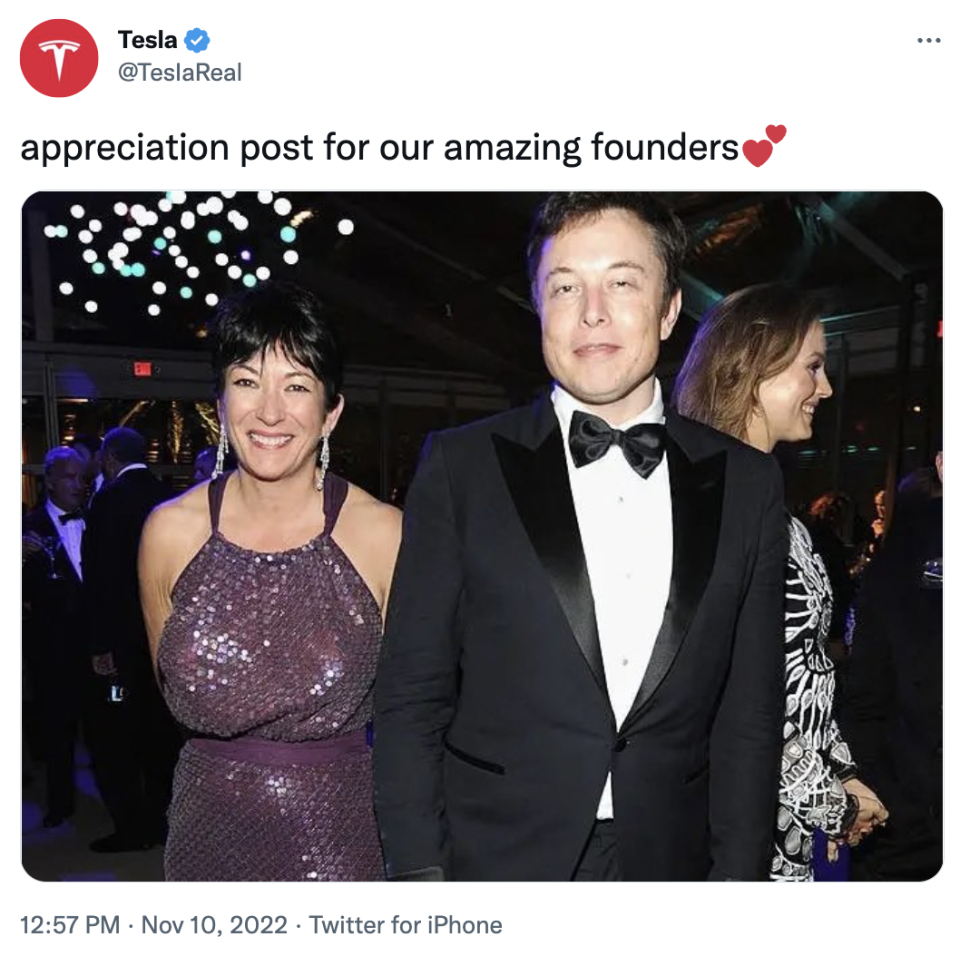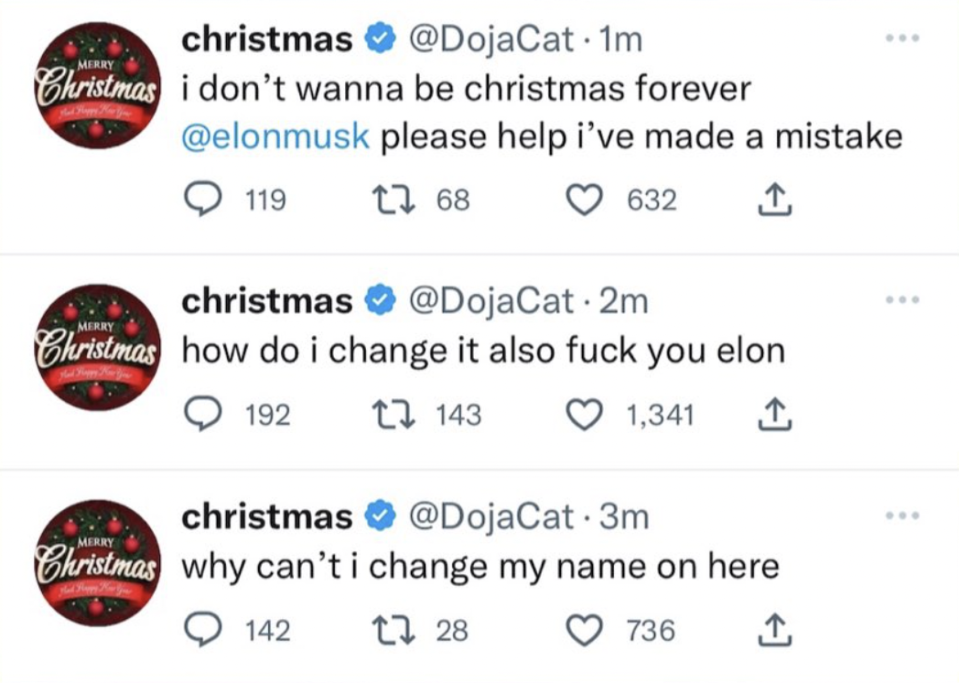Twitter Chaos Reigns as Musk Continues to Throw Spaghetti at the Wall
- Oops!Something went wrong.Please try again later.
- Oops!Something went wrong.Please try again later.

As Elon Musk‘s second week running Twitter comes to a close, the social network is tilting toward outright anarchy.
The most visible problem arose from Musk’s harebrained idea of selling verification badges for $8 a month through the premium subscription Twitter Blue — without a mechanism for confirming the user’s identity. For years, you could trust that a blue check next to, for example, the name “Rudy W. Giuliani” indicated that the account was controlled by the former mayor of New York. With Musk’s version of Twitter Blue, for a quite reasonable price, anybody can log on as the “real” Giuliani and tweet stuff like “I shidded” until they’re suspended.
More from Rolling Stone
Elon Musk's Free-For-All Twitter Policy Led to Someone Impersonating a US Senator
Elon Musk's Twitter Acquisition May Upend The Music Industry's Biggest Forum
I see the "verification" system is going juuuuuuuuuuuust great. pic.twitter.com/Ck8N5WTReb
— Mike Masnick (@mmasnick) November 9, 2022
It’s no wonder that the program lasted less than three days before Twitter abruptly reversed course (once again) Friday morning, pausing the paid verification program. The day before, the company had quickly backtracked on their abrupt cancellation of a second, short-lived “Official” check mark label, hoping to thwart further pranks. But with the rules shifting so rapidly from hour to hour, opportunities for mischief abound.
Even as internal reports say the company is foundering, Musk continues to tweet positively about Twitter’s usage rate, and says the check mark system “needs some tweaks, but overall proceeding well.” In an another effort to stem the tide of deceptive and joke accounts, Musk — who in October celebrated his purchase of Twitter by tweeting that comedy was now “legal” on the platform — announced that any parody feed without the word “parody” in the name would be in violation of policy.
We’re not currently putting an “Official” label on accounts but we are aggressively going after impersonation and deception.
— Twitter Support (@TwitterSupport) November 9, 2022
To combat impersonation, we’ve added an “Official” label to some accounts.
— Twitter Support (@TwitterSupport) November 11, 2022
Going forward, accounts engaged in parody must include “parody” in their name, not just in bio
— Elon Musk (@elonmusk) November 11, 2022
As the false accounts proliferated this week, Musk pointed out impersonators were being taken down after they were reported, but this set off an unwinnable game of Whac-A-Mole. People have already impersonated President Biden, Donald Trump, LeBron James, Mark Zuckerberg, O.J. Simpson, George W. Bush, Tony Blair, George Washington, Florida Gov. Ron DeSantis, the Canadian Broadcast Corporation, Mr. Bean, Dave Chappelle, Glenn Greenwald, Sen. Ted Cruz, Arizona gubernatorial candidate Kari Lake, Ben Shapiro, Pope Francis, Pope John Paul I, Martin Luther, ESPN analyst Adam Schefter, Nestlé, Pepsi, Coca-Cola, McDonald’s, Apple TV+, the produce distributor Chiquita, the doll brand American Girl, oil and gas company BP, defense contractor Lockheed Martin, the American Israel Public Affairs Committee, the Anti-Defamation League, several video game companies (Nintendo, Roblox and Valve), pharmaceutical giant Eli Lilly, Musk’s rocket company SpaceX, and, in several cases, Musk himself. There’s also a verified Jesus Christ.
On Thursday, someone posing as the verified account of Musk’s car manufacturer Tesla shared an infamous photo of him with convicted child sex trafficker Ghislaine Maxwell, presenting the pair as the “amazing founders” of the company.

Unsurprisingly, brands have shown concern over the state of moderation on Twitter this month. The advertising behemoth IPG advised its clients — including American Express, Coca-Cola, Mattel, Johnson & Johnson and Spotify — to pause spending on Twitter buys. General Mills, Audi, Pfizer and General Motors have also halted their advertising, continuing a downward trend that began long before Musk took the reins. He said Twitter suffered a “massive drop in revenue” as a result.
On Friday, the theater magazine Playbill became the first major media outlet to signal their departure from the site, sharing a statement that cited a rise in hate speech and said it would be “irresponsible” to continue using a platform “where we and our readers cannot legitimately decipher actual news from insidious rhetoric.” High-profile users are leaving as well, from TV producer Shonda Rhimes to singer Toni Braxton to “Miracle on the Hudson” pilot Chesley “Sully” Sullenberger. Though perhaps more concerning for Musk is the gradual loss of Twitter’s most active users, which has been ongoing since the start of the COVID-19 pandemic.
— Playbill (@playbill) November 11, 2022
Meanwhile, Musk has been plotting ways to weaken the status of what he calls “Legacy Blue” users — the dreaded old guard who were granted blue checks between 2009 and his takeover. Some Twitter Blue subscribers were dismayed to see that it’s still possible to tell who paid for their check and who has one because they’re “notable in government, news, entertainment or another designated category.” At first, Musk promised to replace that text with a pop-up reading: “Legacy Verified. Could be notable, but could also be bogus.” A day later, he took a harsher line, tweeting: “Far too many corrupt legacy Blue “verification” checkmarks exist, so no choice but to remove legacy Blue in coming months.”
— Professional Comedy Judge (@enelum_) November 10, 2022
The legacies did notice an immediate problem under Musk’s paid verification scheme: for some reason, they could no longer edit their avatars or display names. Doja Cat, who got temporarily stuck tweeting as “christmas,” was none too pleased about it, though by Thursday night was able to update to “fart.”

You should be able to change your name now
— Elon Musk (@elonmusk) November 10, 2022
thank u elon @elonmusk
— fart (@DojaCat) November 11, 2022
The situation at headquarters is even more unruly. After Musk laid off half of Twitter’s staff, management begged dozens to come back, either because they were “accidentally” let go or essential for daily operations. Musk, who has sold some $4 billion in Tesla stock in what he has characterized as a bid to “save” Twitter, informed remaining employees in his first official communication with them, a dire email sent Thursday at 2:39 a.m. ET, that they could no longer work remotely (which he later walked back) and “there is a good chance Twitter will not survive the upcoming economic downturn.” He also discussed turning Twitter into “the people’s financial institution.”
In a subsequent all-hands meeting, Musk reaffirmed a point from his email: at the rate the company is bleeding money, bankruptcy is a possible outcome. He indicated a drive to act impulsively, saying that the company needed “a maniacal sense of urgency” and that “we want to try things, ideally things that don’t break the whole system, but I think as long as we’re agile and we react quickly to improve things and correct mistakes, I think it’ll be fine.” And he expressed a desire “to see ads for gizmos.”
Wow. Elon Musk just told Twitter employees he’s not sure how much run rate the company has and “bankruptcy isn’t out of the question.”
— Zoë Schiffer (@ZoeSchiffer) November 10, 2022
Musk borrowed $13 billion from Wall Street banks that have already come to see the debt as an “albatross” in today’s unfavorable credit market, per a Bloomberg report, and they’ve begun seeking investors to buy it at a steep discounts — which would mean taking enormous losses themselves. As tech and business journalist Kara Swisher noted, Musk could lose control of Twitter and wind up reporting to a boss if hedge funds assume the debt.
Elon should buy the debt or he’ll get a boss: Twitter Buyout Loans Get Bid at 60 Cents as Banks Sound Out Investors – Bloomberg https://t.co/cPVwnVZpzC
— Kara Swisher (@karaswisher) November 11, 2022
The upheaval at Twitter headquarters has been exacerbated by a slew of high-profile resignations. On Thursday, it emerged that Yoel Roth, Head of Trust and Safety — who since Musk’s takeover has worked to mitigate a spike in hate speech and reassure users amid the chaos — is leaving the company. He was joined by a director of human resources, Kathleen Pacini. Their departures follow those of three executives responsible for overseeing information security, privacy and compliance. And, of course, Musk fired most of the C-suite as soon as he took control of Twitter. In one article, The Verge reported that they were unable to reach Musk for comment because Twitter “no longer has a communications department.”
what a sentence pic.twitter.com/AHeoseVX63
— ian bremmer (@ianbremmer) November 10, 2022
The effects of the growing leadership vacuum, understaffing, and cratering employee morale will be acute, not only as Twitter infrastructure itself falls apart from a lack of maintenance, but as Musk’s freewheeling business practices draw scrutiny from the U.S. government. President Biden himself has said that the billionaire’s foreign ties are “worthy of being looked at,” while the Federal Trade Commission made the unusual move on Thursday of issuing a stern warning to Musk.
“We are tracking recent developments at Twitter with deep concern,” said an FTC spokesperson in a statement. “No CEO or company is above the law, and companies must follow our consent decrees. Our revised consent order gives us new tools to ensure compliance, and we are prepared to use them.”
According to messages shared in Twitter Slack, Twitter’s CISO, chief privacy office, and chief compliance officer all resigned last night.
An employee says it will be up to engineers to “self-certify compliance with FTC requirements and other laws.”— Casey Newton (@CaseyNewton) November 10, 2022
The consent decree is an agreement between the FTC and Twitter that the latter will safeguard user information while thoroughly documenting the implementation and security of any new features or services. It’s a binding pledge that Musk apparently doesn’t care about, and with a lot of important people who do care jumping ship, that indifference could cost him dearly.
The agency first obtained this deal in 2011, when settling with Twitter over charges of serious lapses in their data security. Earlier this year, the company paid $150 million for allegedly violating the decree — it had asked users for personal information, supposedly in order to secure their accounts, then served targeted ads based on the responses.
As part of that settlement, the FTC also rewrote the consent decree to be even stronger. Among other things, it now requires a risk assessment before the rollout of any modified product or service that requires access to a customer’s private data. The pace at which Musk is inflicting change on Twitter suggests that those assessments are very much not happening, even if he said in the all-hands Q&A that his experience on privacy and security at Tesla and SpaceX would equip him deal with similar issues at Twitter.
So insiders are now worried that Musk’s reckless antics, and his demand that engineers “self-certify” their compliance with FTC rules and privacy laws, may trigger billions in fines, if not criminal penalties. It’s certainly not ideal for Twitter that the consumer protection body is already threatening to enforce the newer, less forgiving legal statutes that Twitter committed to just months ago, while a company lawyer is advising employees to obtain whistleblower protection “if you feel uncomfortable about anything you’re being asked to do.” Moody’s Investors Service no doubt foresaw this breakdown of standards and practices at Twitter when downgrading the company’s credit rating due to “governance risk” the moment Musk completed his leveraged buyout.
But on Friday, Musk’s attention was trained on the press he has often criticized alongside, or as synonymous with, the “Legacy Blue” brigade. While agreeing with far-right troll Ian Miles Cheong that filtering out disinformation was tantamount to censorship, he claimed he had “disrupted” the mainstream media’s “oligopoly on information,” and that the “media elite will try everything to stop that from happening.” Minutes later, however, he decided that the negative coverage is actually good, since it’s “driving massive growth in Twitter!”
Mainstream media will still thrive, but increased competition from citizens will cause them to be more accurate, as their oligopoly on information is disrupted
— Elon Musk (@elonmusk) November 11, 2022
https://twitter.com/elonmusk/status/1591142426034720773
Despite Musk’s mercurial approach to this job, he has yet to maneuver around one fact: the disasters of his own making are expanding and compounding at an astonishing rate, while the potential consequences are escalating in kind. Can a gutted, destabilized Twitter, led by a flailing egomaniac, withstand another week of this nonsense? Maybe not, but rest assured that many will stick around to watch the train wreck.
Some epically funny tweets 🤣🤣
— Elon Musk (@elonmusk) November 11, 2022
This story has been updated
Best of Rolling Stone

